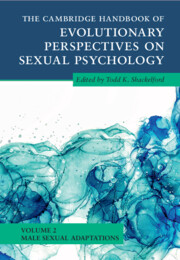Book contents
- The Cambridge Handbook of Evolutionary Perspectives on Sexual Psychology
- The Cambridge Handbook of Evolutionary Perspectives on Sexual Psychology
- Copyright page
- Contents
- Contributors
- Preface
- Part I Precopulatory Adaptations
- 1 Men’s Sexual Preferences
- 2 Men’s Extra-Pair Sexual Interest
- 3 Male Sexual Attraction Tactics
- 4 Men’s Intrasexual Competition
- 5 Competitiveness and Fatherhood as Overarching Domains of Female Choice in Human Evolution
- 6 Sexual Coercion and Rape
- 7 Mate Poaching by Men
- Part II Copulatory Adaptations
- Part III Postcopulatory Adaptations
- Index
- References
5 - Competitiveness and Fatherhood as Overarching Domains of Female Choice in Human Evolution
from Part I - Precopulatory Adaptations
Published online by Cambridge University Press: 30 June 2022
- The Cambridge Handbook of Evolutionary Perspectives on Sexual Psychology
- The Cambridge Handbook of Evolutionary Perspectives on Sexual Psychology
- Copyright page
- Contents
- Contributors
- Preface
- Part I Precopulatory Adaptations
- 1 Men’s Sexual Preferences
- 2 Men’s Extra-Pair Sexual Interest
- 3 Male Sexual Attraction Tactics
- 4 Men’s Intrasexual Competition
- 5 Competitiveness and Fatherhood as Overarching Domains of Female Choice in Human Evolution
- 6 Sexual Coercion and Rape
- 7 Mate Poaching by Men
- Part II Copulatory Adaptations
- Part III Postcopulatory Adaptations
- Index
- References
Summary
The present chapter advances the view that women’s mate preferences can be grouped into at least two overarching domains: competitiveness and fatherhood. Theoretical and empirical considerations suggest that female mate preferences evolve in contexts of male competitiveness and often amplify the effects of male–male competition. Evidence for the importance of male–male competition and female choice for competitiveness in humans is reviewed. Evidence is likewise offered for the importance of human fatherhood as an additional domain of female choice outside of male competitiveness. Implications of more inclusive mate preferences for the evolution of cognitive architecture are discussed alongside the social and ethical implications of female choice for competitiveness.
- Type
- Chapter
- Information
- Publisher: Cambridge University PressPrint publication year: 2022



